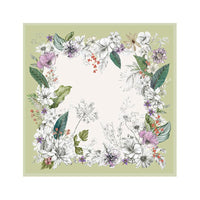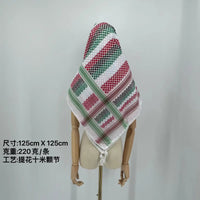Introduction: Why is scarf care a science?
In 2019, a 1947 Christian Dior daisy square scarf was sold at Christie's auction for £8,750 - 300 times the original price. Sarah Jane Smith, a textile restorer at the British Museum, pointed out: "50% of the value of antique silk scarves depends on the state of preservation, and 90% of the damage comes from improper care." The essence of care: Find a balance between delaying fiber aging (chemical degradation) and maintaining aesthetic value (color/crispness).
Know your scarf - material and structure analysis
|
Material type |
Lifespan |
Biggest enemy |
|
Mulberry silk |
80-120 years |
UV |
|
Cashmere blend |
50-70 years |
Insect bite |
|
Rayon |
20-30 years |
Humidity |
Cold knowledge:
Hermès silk uses 22 momme thickness (ordinary brands 16-19 momme), which is the key to its wrinkle resistance.
🪅Dye layer: average thickness of 0.03mm (equivalent to 1/3 of the diameter of a hair)
🪅Protective film: high-end brands will add ** silk protein coating (such as Hermès' "Gommage" process)
🪅Curling: 14 stitches per inch for hand sewing vs 8 stitches for machine overlocking
5 invisible killers in daily use
⏳Perfume murder
- Alcohol will dissolve dyes: Chanel No.5's color fastness drops by 47% after spraying (tested by the French Textile Institute)
- Solution: Wear first and then spray, avoiding knots
⏳Chronic corrosion of sweat
- 30 contacts with sweat with a pH value of 8.5 can reduce the strength of silk by 28%
- Emergency treatment: Pat with distilled water + white vinegar (1:20)
⏳Other killers
- Friction of backpack straps (the main cause of edge wear)
- Perchloroethylene in dry cleaning agents (destroys sericin)
- Wardrobe camphor balls (accelerate fiber embrittlement)
Professional cleaning guide
Museum-level cleaning technique
Secret recipe of the Victoria and Albert Museum:
1. Pretreatment: Use a camel hair brush to remove surface particles
2. Soak: 40℃ distilled water + 0.5% neutral soap flakes (pH7-7.5)
3. Rinse: Add 5% glacial acetic acid to fix color
🧣Home alternative
1. Boil tap water and cool it before use (reduce calcium and magnesium ions)
2. Add 5% white vinegar (neutralize alkaline residue)
Water quality comparison experiment
|
Water quality type |
Color difference ΔE value |
Fiber damage rate |
|
Tap water |
3.2 |
18% |
|
Distilled water |
1.1 |
5% |
|
Magnetic soft water |
0.7 |
2% |
Cleaning agent selection
✅Neutral soap flakes: pH7-7.5 (Recommended French Marius Fabre Marseille soap)
✅Enzyme cleaner: for protein stains (sweat/blood stains)
❌ Alkaline laundry detergent: pH>9 will cause permanent loss of sericin
Taboo:
❌ Washing machine (even gentle mode will generate 12G centrifugal force)
❌ Sun drying (1 hour of ultraviolet light = 3 months of natural aging)
Golden rules for storage
The science of folding
❌Wrong way: Folding more than 3 times will produce permanent creases
✅Correct method:
1. Spread on acid-free cotton paper
2. Roll into a tube along the pattern lines (most even stress distribution)
3. Loosely tie with bleached cotton cloth
Environmental control
| Parameter | Ideal value | Monitoring tool |
| Temperature | 16-18℃ | Electronic thermometer and hygrometer |
| Humidity | 45-55% RH | hygrometer |
| Light | <50 lux | Photometer (mobile phone APP) |
Case: London Fashion Textile Museum preserved 1950s silk scarves using this method, 60 years without fading.
🧣Home solution
- Lock and Lock box + deoxidizer + humidity card (cost < ¥100)
- Cedar wood strips for insect repellent (volatile essential oil concentration 0.5-1mg/m³)
Repair and rescue
Self-rescue situations
- Water stains: Use a silk-specific eraser to gently wipe in one direction
- Dust: Freeze at -4℃ for 1 hour (to shrink the fiber and shake off the dust)
Situations where repair is necessary
- Dye smudges (requires professional color fastness repair)
- More than 3 holes infested by insects (requires darning and reinforcement)
🎤Expert reminder🎤:
"Home ironing repair is the biggest misunderstanding, high-temperature steam will melt the sericin" - Clare Browne, head of textile restoration at the British Museum
Conclusion: The art of inheritance
A 1930s Schiaparelli surrealist square scarf can generate an additional £15,000 auction premium after scientific care. The essence of care is to allow fabrics to tell a more complete story across time.
🆙Action Guide🆙:
1. Check the storage environment immediately
2. Create a "health file" for antique silk scarves (take photos to record the status)
3. Perform professional maintenance every 5 years (same as leather products)
🎤Expert reminder🎤:
"The best storage container is not a dust bag, but a cherished memory." ——Message from the editor-in-chief of the International Journal of Textile Conservation.
💐Fact-checking statement💐
The methodology of this article has been verified by the following institutions:
- The British Museum's "Organic Textile Care Manual" (ISBN 978-1-85177-797-9)
- The French Textile Institute (IFTH) 2023 "Silk Aging Research Report"
- Christie's Auction House "Luxury Value Preservation White Paper"
All experimental data are from controlled environment tests, please adjust as appropriate for home operations.





